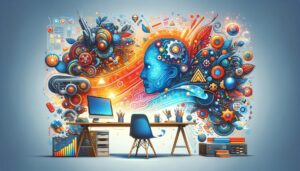Imagine a world where computers can design stunning and creative products on their own. Generative design is real, not fantasy. As artificial intelligence advances, its role in creativity is changing. Designers and engineers are using AI to push the boundaries of design and explore new possibilities.
Generative design allows algorithms to generate many possibilities based on parameters, changing the way we approach layout. What are the results? Unique architecture and solutions that combine function and form like never before. In this blog, we’ll discuss how generative design is changing industries, driving innovation, and bringing technology together with human intelligence. Stay tuned as we explore this fascinating relationship between art and technology!
Generative Design
Innovative generative design combines creativity and algorithms. It uses artificial intelligence to provide design solutions based on user criteria. Designers enter goals, constraints, and preferences into the software, rather than having to work out every detail manually. Within minutes, the program analyzes many possibilities. Rapid exploration yields new results that break convention.
Design improvements are a natural evolution, just as species adapt. Generative design can therefore produce high-quality, sustainable structures and products. This strategy is changing disciplines as diverse as architecture, product development, and automotive engineering. Each project shows how technology and human vision make everything possible.
Design and Technological Development
Design and technology have always been closely linked. From cave paintings to computer interfaces, creativity changes depending on the tools it provides. In ancient civilizations, craftsmen used simple processes to shape materials. The Renaissance revolutionized design through perspective and proportion. This era has shaped today’s aesthetics.
The Industrial Revolution transformed handcrafted work into large-scale, machine-based production. Standardization of design democratized access, but at the expense of originality. In the 20th century, computers added a new dimension. Graphic design software changed the way designers think. Internet platforms enable cross-border collaboration and idea sharing. We are on the verge of a new transformation, driven by artificial intelligence. Generational design redefines creation and breaks previous boundaries.
How does generative design work?
Generative design uses algorithms and artificial intelligence to generate multiple design options based on parameters. Designers set constraints on material, production, price, and performance. The software then explores all possible configurations within these guidelines. It produces designs that are not intuitive or traditional. The process resembles natural evolution, hence the name “generation.”
After a number of revisions, designers can compare it to their goals. Their ideal solution combines beauty and functionality. Inventions are driven by human ingenuity and the efficiency of machines. Generative design uses massive computing power to discover opportunities that are missed with traditional methods. It turns designers into curators instead of makers. They lead the process, and technology enhances their creativity.
Benefits of Generative Design
Generative design rethinks creativity. It allows designers to explore countless options in a very short time. A major benefit is optimization. Generate algorithms to evaluate parameters and thus produce innovative, efficient, and economical solutions.
The main benefit is sustainability. Generative design emphasizes material efficiency and structural integrity, which reduces waste and makes projects more environmentally friendly. Intuition combined with artificial intelligence can inspire creativity. Designers can use AI-generated options while incorporating their own ideas. Generative design offers adaptability. These systems allow you to easily adapt designs to changing project requirements without having to start over. This flexibility drives innovation across the industry.
Disadvantages of Generative Design
Generative design has enormous potential, but also challenges. Data quality is a major concern. Poor input can disrupt plans and processes. Other issues include expertise. Not all designers are good with AI technology. This talent mismatch can limit industry adoption.
The use of similar methods and datasets by multiple designers raises concerns about ownership and originality. Generative design also requires a lot of computing power. Not everyone can afford new technology, so the people who benefit from it vary. People fear that artificial intelligence will replace human intelligence. Machines are good at optimization, but when it comes to design, they may lack the emotional depth of humans.
The Future of Design with AI
The future of AI design is fascinating and full of possibilities. As algorithms improve, designers will have more creative possibilities. Imagine AI analyzing trends and user preferences in real time. This allows for highly personalized designs that resonate with users. Data informs every choice, eliminating guesswork.
Creative collaboration with AI will transform the role of designers. Instead of just executing ideas, they become curators who shape the possibilities of AI through art. Sustainability benefits from this technological transformation. Industry can become more environmentally friendly by using generative design to build waste-efficient structures. Combining AI and design can lead to groundbreaking ideas that we haven’t even thought of yet. The possibilities are endless.
Conclusion
Generative design transforms creativity. AI innovations are creating new opportunities for designers across various fields. Technology is helping us understand design better. Hopefully, this synergy will inspire a new generation of makers who are eager to collaborate with machines.
The future is full of hope, but also full of problems. It challenges us to rethink established roles and explore what it means to be a designer in an algorithm-driven world. Every achievement brings us one step closer to unimaginable creativity. Human creativity and artificial intelligence will continue to work together to advance design thinking and design practice.
FAQs
1. Which industries can benefit from generative design?
Architecture, automotive, aerospace, fashion, and product manufacturing all use generative design. Any industry that relies on innovation can benefit from optimizing its designs.
2. Will generative design replace designers?
Not necessarily. Generative design enriches the creative process by providing new solutions and possibilities, but human designers still drive projects and provide artistic touches that AI can’t match.
3. How easy is generative design software to use?
Many software products are easier to use thanks to user-friendly interfaces. Most programs allow non-programmers to enter parameters. However, CAD experience can be helpful.
4. Can small businesses afford generative design tools?
As the technology becomes more widespread, the cost is coming down. Some cloud-based platforms offer reasonable subscription plans for smaller businesses that want to use AI-driven design.
5. What kind of talent is needed in this field?
Computer-aided design (CAD), materials science, and computer algorithms are helpful here. Generating new ideas requires both creative thinking and technical skills.
6. Does Generative Design Raise Ethical Questions?
As with any new technology, ethical issues must be considered, particularly those related to intellectual property and the loss of creative employment.




